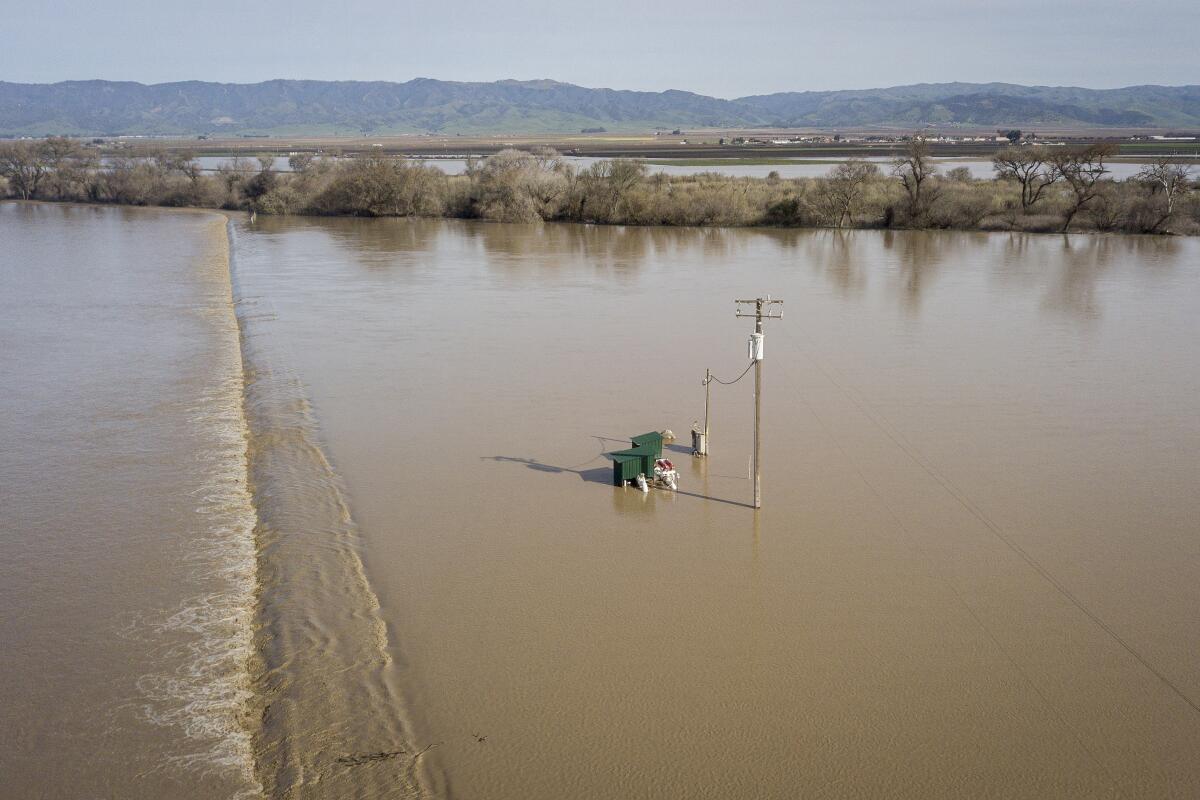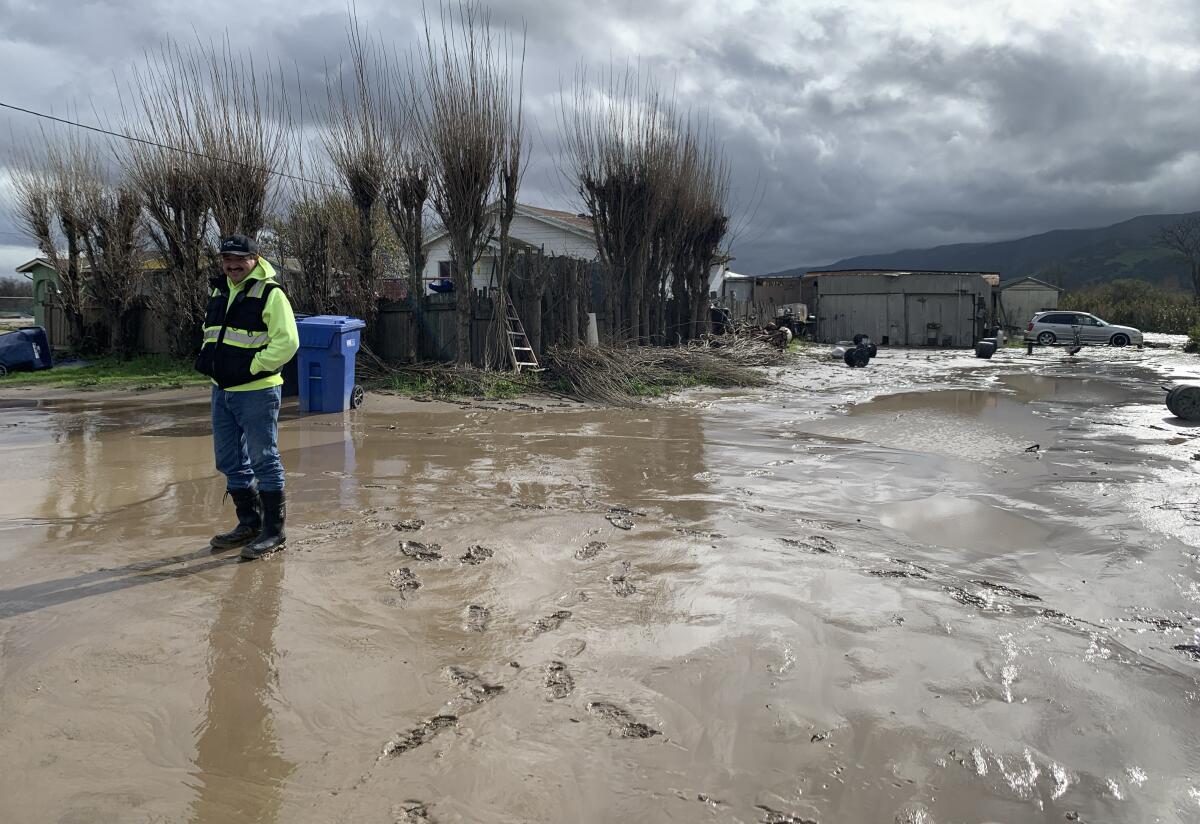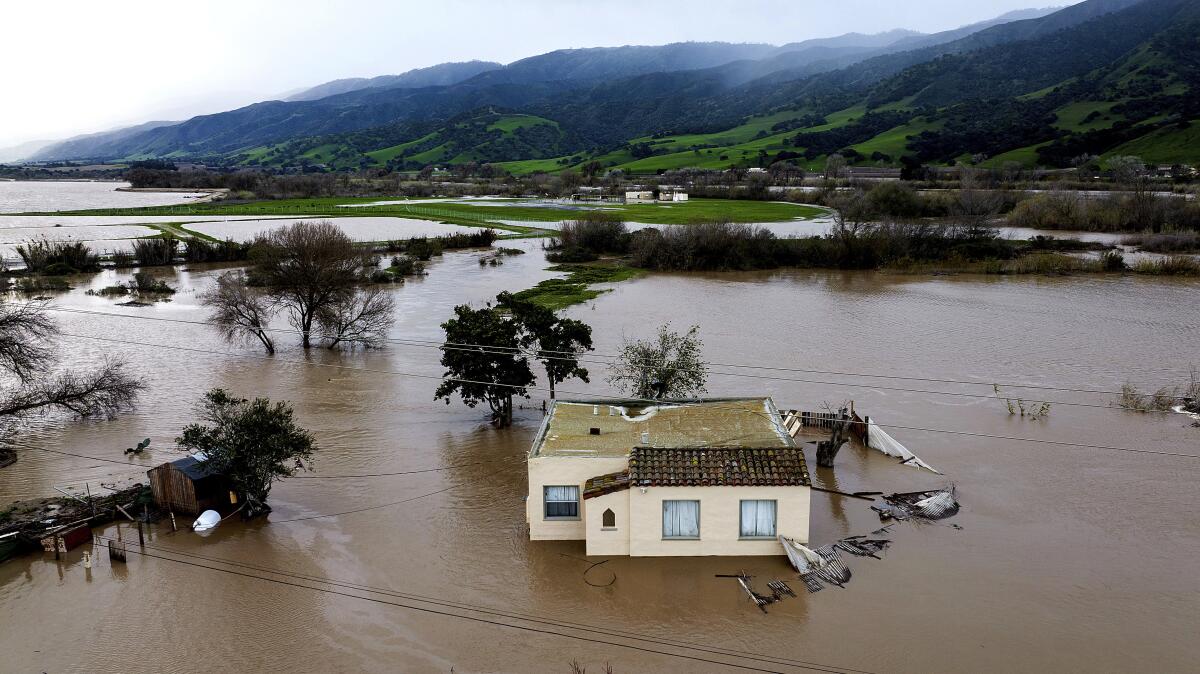‘Not out of the woods yet’: Latest California storm brings fresh dangers and worry

SALINAS, Calif. — Irene Merrill knows all too well the quiet — and the fury — of the Salinas River.
For 55 years, she has lived in this fertile agricultural river valley called the Salad Bowl of the World. She was in high school when the river flooded in 1969, cutting the Monterey Peninsula off from the rest of the state, keeping kids out of school for days.
“The Salinas River is normally pretty lazy and quiet, but when it floods, it causes tremendous destruction,” Merrill, 69, said Friday, when it was doing just that.
Merrill had driven her Honda CRV out to the Salinas to see its chaos. Nearby, the tiny community of Old Hilltown was under several feet of water, courtesy of the latest atmospheric river storm battering the beleaguered Golden State.
The latest storm system — which prompted evacuation orders and warnings across the state — began moving into California early Friday, again raising flooding concerns across the San Francisco Bay Area and the Central Coast.
The threat was particularly acute along the Salinas, where, officials warned, flooding in the coming days could shut down major roadways, including Highways 1 and 68.
By Friday morning, low-lying fields and farmland near the little town of Chualar were submerged in murky brown water from the Salinas, which had breached some levees.
“These storms continue to be dangerous and dynamic, and pose a threat to communities throughout the state of California,” Nancy Ward, director of the California Office of Emergency Services, said Friday. “We are not out of the woods yet. The threat to communities remains, and waters will continue to rise even after these storms have passed.”
David Lawrence, a meteorologist with the National Weather Service, said that most of California was beyond saturated, susceptible to flooding, mudslides and landslides, coastal erosion and downed trees. Heavy rains, strong winds and more snow in the mountains are expected yet again Saturday, he said.
County officials and forecasters began warning Thursday that severe flooding from the Salinas River could overrun Highways 1 and 68, which would effectively cut off the Monterey Peninsula from the rest of the Bay Area.
But updated forecasts Friday morning predicted that flooding would remain less severe, making that possibility less likely.
“It doesn’t look like [the flow from upstream] was quite as strong as anticipated,” said Colby Goatley, a meteorologist with the National Weather Service in Monterey. The river-level forecasts incorporate expected rainfall and upstream flow, the latter of which appeared weaker early Friday, he said.
The Salinas River at the town of Spreckels rose above flood stage — beginning at 23 feet — Thursday evening, reaching 24.5 feet by 8 a.m. Friday, according to the National Weather Service. The river peaked at 24.6 feet Friday and was expected to remain in flood stage through Saturday, according to projections from the California Nevada River Forecast Center.

“It’s a lot of unknowns,” said Nicholas Pasculli, spokesperson for Monterey County. “I hate to have to say that, but it requires constant monitoring.”
Despite flooding affecting some roadways, Highways 1 and 68 were open as of Friday afternoon, Pasculli said. The flooding could be compounded this weekend by heavy rain and high winds, he said, or tides from the Pacific Ocean could also affect the behavior of the river.
“We just all need to have situational awareness regarding the river,” Pasculli said. “The water’s gonna do what the water’s gonna do.”
The Salinas is that famed river of “East of Eden,” in which John Steinbeck wrote: “It was not a fine river at all, but it was the only one we had and so we boasted about it — how dangerous it was in a wet winter and how dry it was in a dry summer.”
On Friday afternoon, Eddie Gonzalez was assessing the damage the river had done to his parents’ property just outside Chualar.
Wearing knee-high rubber boots, he walked gingerly through the thick mud that blanketed the driveway, yard and fields behind the house.
“Watch yourself. That’s all raw sewage,” he told a Times reporter, pointing to the ground.
Gonzalez said the river had washed away four sewage water ponds just upriver. All the water sitting in the fields behind his parents’ home of 43 years — the house he grew up in — and the muck on the driveway were filled with sewage.
He said the same thing happened in 1995 — although, that time, the water got into the house. This time, it came up to the fence but only trickled in through a space below the back gate.
“This is bad but not nearly as bad as that flood,” he said. As the sun came out, Gonzalez noted that the water surrounding his family’s home had already started to recede compared with late Thursday.
At Alma’s Bakery and Deli in Chualar, a cashier, who declined to give her name, said the tiny town was elevated enough to keep her store safe. Outside the front door, two boot scrubbers were situated just off to the side — allowing for customers to clean caked mud off their boots before entering.
In Salinas, schools were closed because of the storm.
An industrial wastewater treatment facility on South Davis Road was also closed Friday. It will likely remain closed through early next week after being compromised by flooding river water, said Sophia Rome, a spokesperson for the city of Salinas.
The treatment facility processes industrial wastewater from agricultural businesses and doesn’t deal with raw sewage, Rome said, but the disruption affects about a dozen agricultural and other industrial dischargers.
“It’s been a harrowing 72 hours, with thousands of people under evacuation orders,” Salinas City Councilman Steve McShane said Friday night. “And thanks to coordinated efforts between city, county, state and national assets, it’s looking like the loss of life and the significant loss of property may have been avoided.”
The river flooded more agricultural land and open space than urban and suburban areas, McShane said. But that agricultural land is important, he said.
“Anybody in farming along the river will have lost any kind of crop that was planted,” he said. “Anybody that’s anxious to visit a salad bar this spring might be doing it at a greater expense or inconvenience.”

Meanwhile, in Mendocino County, flood watches remained in effect along the Navarro and Russian rivers on Friday, though most of those areas weren’t expected to reach flood stage until the weekend.
In addition to the Salinas, Russian and Navarro rivers, other locations were expected to exceed flood stage over the next few days, including the Sacramento River and the San Joaquin River area, according to Department of Water Resources officials.
Friday’s storm was the eighth atmospheric-river-fueled event in California since Christmas. At least 19 people have died in the winter storms.
“The full weight of the federal and state government has been rapidly deployed to try to protect our impacted communities,” Ward, the state Office of Emergency Services director, said Friday at a news conference.
She was joined by the director of the Federal Emergency Management Agency days after President Biden approved an emergency declaration for California. Ward said officials had positioned resources and crews across the state for continued storm response and recovery, including the California National Guard in Santa Barbara.
Speaking at a news conference in Montecito, Gov. Gavin Newsom said the storms highlighted the need for infrastructure improvements, including upgrading flood protection and stormwater-capture systems.
Doing so is critical, he said, in a time of climate change when “the hots are getting a lot hotter, dries are getting drier, and the wets are getting a lot wetter.”
“The question is, are we resilient enough ... are we resourceful enough to be more creative, so that we can thrive, not just survive, through this new reality?”
Los Angeles Mayor Karen Bass on Friday declared a local state of emergency after storms pounded the city earlier this week, causing mudslides, flooding and road closures.
The city is expecting another storm to move in by Saturday, not only raising the possibility of more damage from the rain but also hindering officials’ ability to address the damage already caused.
Bass’ emergency declaration directs city departments to continue assessing estimates on storm damage and to seek state and federal assistance. It also asks the governor’s office to waive regulations that would slow recovery efforts.
Times staff writers Christian Martinez, Salvador Hernandez and Rong-Gong Lin II contributed to this report.
More to Read
Sign up for Essential California
The most important California stories and recommendations in your inbox every morning.
You may occasionally receive promotional content from the Los Angeles Times.














